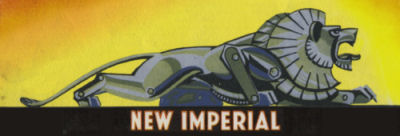


New Imperial Cycles, Ltd., Princip Street, Birmingham.
1887 The history of New Imperial, founded by Norman Downes, goes back to the early days of the bicycle industry in Birmingham. From 1887 New Imperial made bicycle fittings and, later, complete bicycles, possibly after he bought the ailing bicycle business of Hearl and Tonks (founded 1892).
1901 It is also said that he created New Imperial in 1901, but no official record of the earliest company formation has been found. He did however market the Imperial motorcycle from 1901 to 1903. The engine was mounted forward of the handlebars with a leather belt driving the front wheel. It failed to sell.
Official records show the formation of a limited company in 1908, called the New Imperial Cycle Company.
In 1910 a machine went into production using a 293cc JAP engine.
In 1912 the registration of New Imperial Motors is recorded, and they offered a range of three motorcycles. A New Imperial, ridden by A. S. Jones in the 1913 Senior TT race, was one of the 63 that failed to finish that year. (24 competitors finished.)
1912 Downs made his return with the revised name of New Imperial and based his company in Loveday Street, Birmingham. He started with three models all using JAP engines.
1913 A 6hp V-twin model was added to the range, which continued until 1916. The firm first raced in the TT.
The Graves Speed King-JAP was produced between 1913 and 1914 by New Imperial and sold by J. G. Graves of Sheffield as their own marque.
Post World War I. The company moved to Hall Green, Birmingham, and added more models to their range.
1921 That year brought success in the TT when Doug Prentice won the 250cc Junior race. Using that to advertise the make, they increased the range still further.
Mid-1920s The firm was now making its own engines and the JAP motors became an option before being dropped.
1924 A report on the 1924 Motor Cycle Show reads:
Another New Imperial of the same class is the super-sports, with a bore of 74 mm. and stroke 80 mm., which has the J.A.P. two-port engine. Druid forks and shock absorbers.
An article on the 1926 Tourist Trophy Races in Motor Sport Magazine reads:
"This firm has taken the bold step of forsaking a proved proprietary engine for one of its own design. Both 350 c.c. and 250 c.c. engines are on the lines of the standard 250 c.c. unit. The 250 c.c. machine has the standard loop frame as used last year. Both have large tanks, standard gear-boxes and special servo brakes. O. S. Davison is now one of the New Imperial team."
1930 The range had been so extensive that the firm decided to cut back and concentrate on six-cylinder model cars.
1932 Major advancements were made with the first appearance of the company's unit-construction models with the engine and gearbox built as one unit, wet-sump lubrication and pivoted-fork rear suspension.
Throughout the early 1930s developments were made on the sporting side and there were many successes.
1936 A 250cc New Imperial ridden by Bob Foster won the Lightweight TT, the last British four-stroke to win the event. Norman Downs died, which further exerbated the firm's financial difficulties, having not recovered from the financial downturn early in the decade.
1939 The company was bought by Jack Sangster, of Ariel, who planned to move it to the Triumph factory in Coventry, but production remained at Hall Green until the end of the decade.
1940 The planned move to Triumph took place, but the factory was bombed. Edward Turner's 3TU model was supposed to carry New Imperial badges, but never saw production. Proposals to use the name after the war did not materialise, so the name was never resurrected.
Sources:
Graces Guide, Motor Sport Magazine, The Motor Cycle